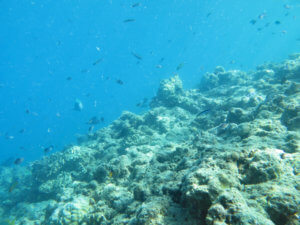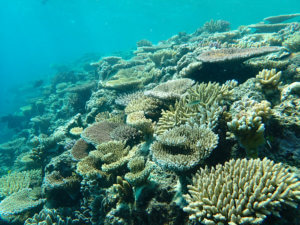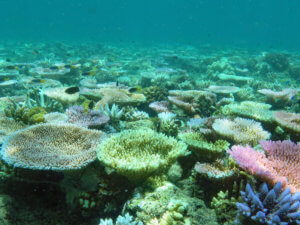As the Great Barrier Reef appears to have largely avoided another mass bleaching event in 2021, one of the scientists who runs the Australian Museum’s Lizard Island Research Station has spoken of the contrasting feelings of hope and anxiety she experiences every summer as the temperature rises.
Dr Anne Hoggett AM has been joint director of the research station since 1990, living and working on Lizard Island to facilitate vital reef research projects by scientists from all over the world.
She said she splits her time on the island into two – before 2014 and after – due to a series of devastating weather events and conditions across the last seven years that have fundamentally changed the coral there. But, she emphasised, a few relatively quieter years have brought her hope with some areas around the island currently showing a good regrowth of corals.
“We experienced two very bad category 4 cyclones just 11 months apart in 2014 and 2015. Around the outside of the island group, almost all the corals were smashed back to bare rock,” said Anne.

Lizard Island reef from April 2015, following the second cyclone
“After those devastating events, I thought, ‘at least we still have the corals in the lagoon’. But then the massive bleaching event happened in 2016. Sadly, it was a comprehensive event for Lizard Island and by March/April of that year, we had lost much of what was remaining. In 2017, the next mass bleaching event hit the Great Barrier Reef. That wasn’t quite as noticeable here simply because there was nothing really left to be killed.
“It took a long time for things to start to recover. Some tiny corals survived the cyclones and bleaching. Initially, there wasn’t much to be seen, but then those little surviving corals began to grow, and the recruitment began to increase again. By late 2019, it looked like recovery was well underway in some places, but not all.
“Thankfully we suffered only minor bleaching in the 2020 event, but when we started seeing the bleaching again this year – for the fourth time in six years – it was terrifying. You learn to live with it and be pragmatic about it but it’s incredibly sad to see corals bleaching and dying.”

By October 2020, this section of the reef at Lizard Island shows good recovery
Anne said she was fairly confident the island would escape a bad bleaching event again this year. As in 2020, that’s because cyclones in the area reduced the water temperature below a critical level and increased shading through cloud cover. But she said they now always worry in summer about what could happen.
“You’re at the mercy of the weather. In the summer, the corals are always so close to their temperature limits, it doesn’t take much anymore to push them to bleach,” she said.
“Before 2014, the Reef seemed to be coping quite well, despite recurring Crown-of-Thorns starfish outbreaks. After, with all those events happening in quick succession, it’s clear that the system is struggling with too many stresses happening too close together.
“The recoveries I’ve seen only give me hope in the short term. I can’t see how the Reef can continue to bounce back time and time again without changing significantly.
“It’s a huge system and so corals in some places will survive. Corals have survived on Earth for millions of years and can recover from disastrous events, recolonise different areas. The difference this time is that it’s us and our actions that are leading to outcomes that can be too much for parts of the Reef.”

This picture taken in February 2021 shows partially bleached and fluorescing corals
Anne said her sadness about the Reef often turned to anger because of government inaction on global heating – the driver of marine heatwaves and extreme weather events that have wreaked so much damage.
“We need to keep lobbying our governments to be more proactive on climate change,” she said.
“It is so frustrating. Of course there’s a lot of reef restoration work happening and research into resilience but that’s not going to save reefs. At best, it will buy us some time. All the scientists involved say the best way to ensure the future of the Reef is to properly tackle climate change by reducing our fossil fuel emissions to zero. Of course, even if we stop burning fossil fuels completely, the planet is still on a trajectory to keep warming because of the damage already done, so I see rehabilitation and restoration projects as a stop gap solution until greenhouse gas effects slow.
“Right now we’re hosting PhD students who are coming to the end of their research projects and a comment by one of them recently made me realise that many of this crop of researchers have never seen the reef at Lizard Island in a good condition.
“He said the reefs were starting to look amazing compared to three years ago when he started work here. But it’s not back to where it was and it may never get there. This could be as good as it’s going to get.
“I will keep hoping, but year after year now it’s nail biting. We are on the edge of our seats to see what will happen.”
The Australian Marine Conservation Society’s Fight For Our Reef campaign shines a light on the issues impacting the Great Barrier Reef including climate change, water quality and fisheries impacts, and advocates for the policies that will give our Reef the best chance for the future. To join the campaign, click here.